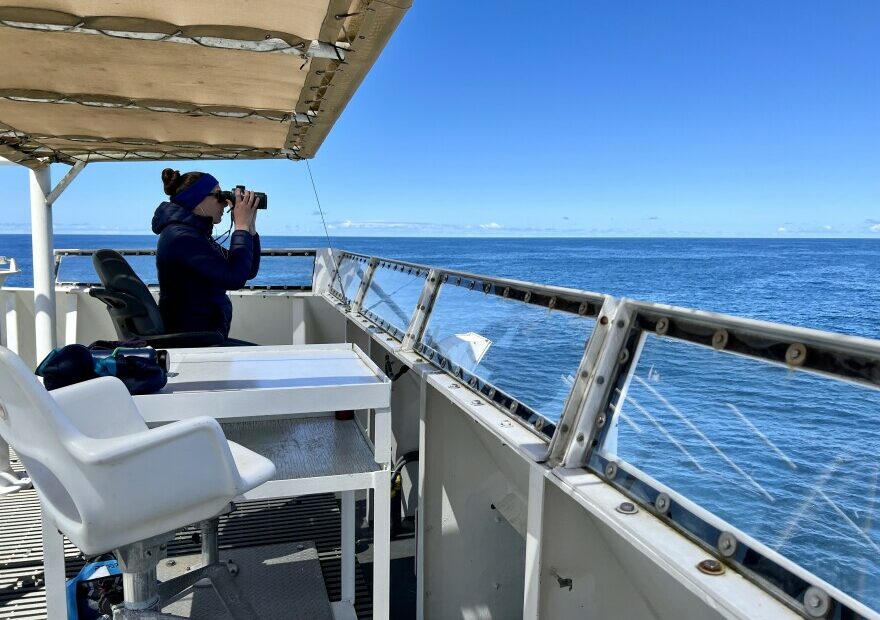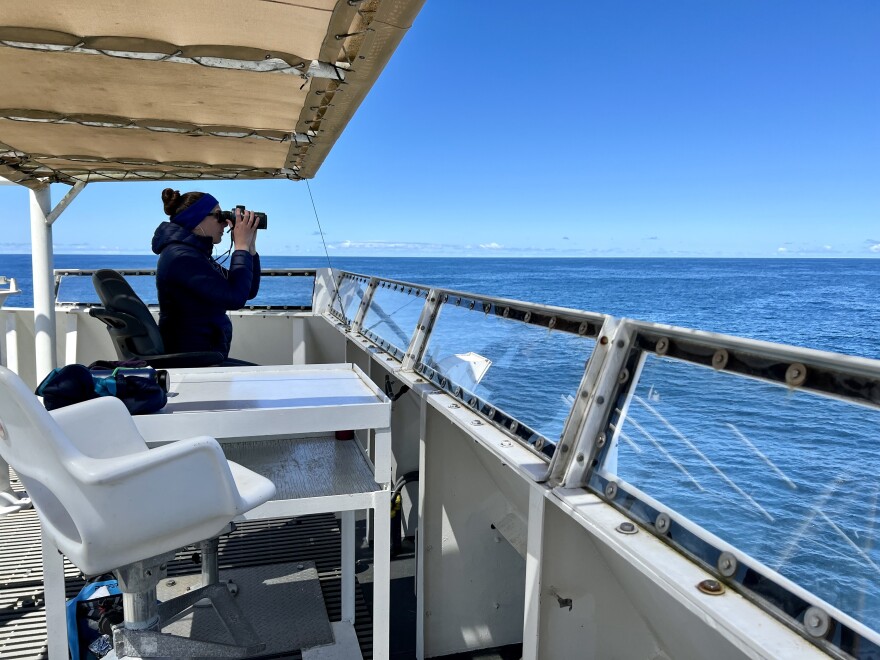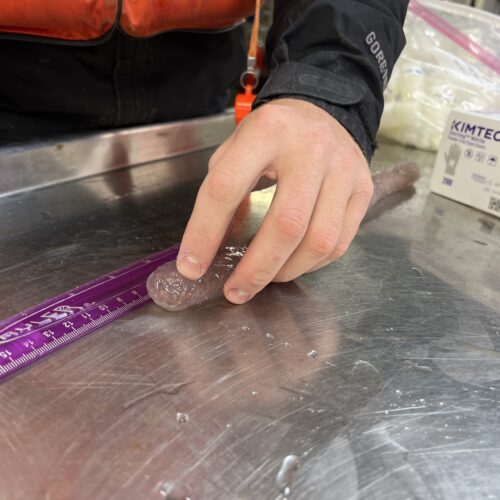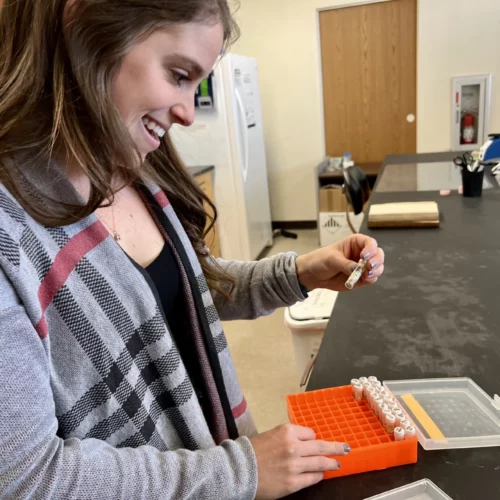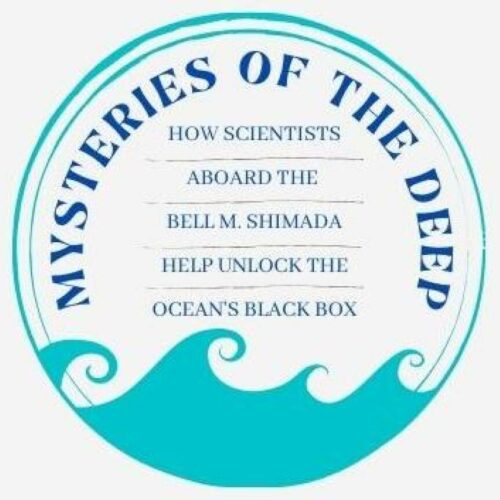High up on NOAA’s Bell M. Shimada’s flybridge – the very top deck, around 13 meters above the water line – the scientists didn’t take their eyes off the water.
The scientists were searching for signs of whales.
Whales need a healthy, functioning ecosystem, which means the presence (or absence) of whales could indicate the health of the surrounding ocean, said Dawn Barlow, with the Geospatial Ecology of Marine Megafauna Laboratory at Oregon State University’s Marine Mammal Institute.
To lessen the eye strain 12 hours of staring could cause, Barlow and Clara Bird, a Ph.D. candidate with the GEMM lab, scanned the ocean waves, varying between watching with binoculars and just using their eyes.
Also close at hand: bottles of eye drops.
“The eye drops were a game changer,” Bird said.
Wind, rain or perfectly flat conditions, the marine mammal observers scanned the seas for any signs of a whale – a water spout in the distance, a dorsal fin breaking the surface, or, if they were lucky, a breach.
These scientists are part of an interdisciplinary 13-person science crew aboard the Shimada from May 6-17. At least twice a year, a science team boards this vessel to sample and observe the Northern California Current ecosystem.
This particular voyage traveled from the San Francisco Bay all the way to La Push, Washington, and back home to Newport, Oregon. Scientists hoped to learn a little bit more about the mysteries of the ocean by sampling, measuring and observing the marine life in it.
Krill acoustics
On this survey expedition, scientist Rachel Kaplan, from OSU, had dual roles.
She watched from the flybridge to see where the whales and other marine mammals popped up. At other times, she spent much of her days three stories below the fresh air of the flybridge, staring at a computer screen that displayed acoustic readings of what was below the water’s surface.
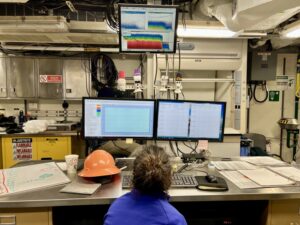
Scientist Rachel Kaplan watches for krill in acoustics frequencies on the Bell M. Shimada. CREDIT: Courtney Flatt
“The backscatter for krill turns up as red. The aggregations can be pretty variable in shape,” said Kaplan, a second-year Ph.D. student with the Krill Seeker Lab at OSU’s College of Earth Ocean and Atmospheric Sciences and OSU’s GEMM Lab.
In what’s known as the ship’s acoustics laboratory, Kaplan said she hoped to spot the acoustic frequencies of krill swarms on a computer readout at the same time mammal observers spot whales.
Then, the chief scientist on the voyage, Jennifer Fisher, asked to stop the ship for what’s known as an opportunistic bongo net drop. The crew dipped a bongo-shaped net into the water, hoping to pull up a bunch of krill.
Whales eat krill, so the two species should be around at the same time.
Protecting krill
Krill are so important to the marine ecosystem that in 2006, the Pacific Fisheries Management Council squashed talk of harvesting krill. In 2009, NOAA enacted a rule that protected krill from commercial fishing up to 200 nautical miles off the U.S. West Coast.
That’s why Kaplan’s krill findings could have big impacts on fisheries management. In recent years, an increasing number of whales, especially humpbacks, have gotten tangled in fishing gear.
“We’re trying to figure out: how can people who fish off the coast keep fishing because that’s so important to people’s livelihoods and Oregon’s economy. But how can we also mitigate entanglement risks to whales?” Kaplan said.
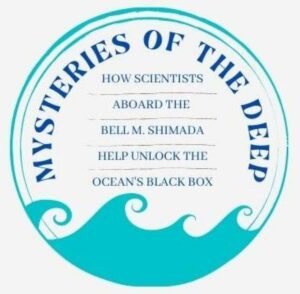
CREDIT: Courtney Flatt
Scientists quickly realized, to answer those questions, they’d need to know more about where to expect whales off the coast of Oregon.
Some marine mammal research has already helped to change policies. For example, in 2021, the Oregon Fish and Wildlife Commission restricted Dungeness crabbing gear. Whales most frequently are reported entangled in crab pots.
Now, the gear must stay inside the 40-fathom depth line, a direct result of marine mammal observations, Barlow said. A fathom is the measurement of your outstretched arm, or about six feet, she said.
On board the Shimada, Kaplan watched for krill frequencies at depths of around 100 meters.
‘Let’s do this’
Typically, the scientists tow for krill at night when the crustaceans surface to eat. At night, the krill have a better chance of avoiding predators, Fisher said. Scientists have found krill will often dive as deep as 200-meters during the daytime.
“But, the water depth right now is only 140-meters, so they can’t go that deep. So, we can catch them, maybe. They’re trapped,” Fisher joked. “They’re probably like, ‘Swim away from the net! Here it comes!’”
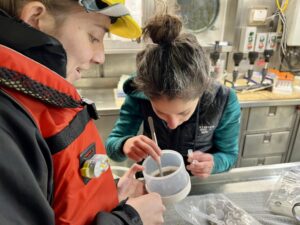
Talia Davis (left) and Rachel Kaplan pick through a filter to find krill. CREDIT: Courtney Flatt
That’s not unusual, Kaplan said. Research shows krill often scatter away from nets.
“They’re just too smart for us,” Kaplan said.
On Kaplan’s first try, the krill did avoid the net.
“I saw the bongo net on the acoustics screen, and we definitely hit it,” Kaplan said of the group she’d thought could be krill.
Instead, the net brought up a group of pteropods, which are plankton that are incredibly sensitive to ocean acidification. The sample also included a few young krill.
Hours later, Kaplan found krill exactly when she expected them to show up. The crew pulled up a net full of what they called krill soup, or filters full of juicy krill.
Kaplan said she’d tied herself in knots, worried the net would be empty. The frequency she’d been watching on the acoustics screen ended just as the net plunged into the water.
“It looked like we were going to miss it, but I think we still got some krill that were in the area,” Kaplan said.
At the same time, the marine mammal observers saw eight humpback whales, all diving to forage for food.
“That was part of what made us say, ‘OK, let’s do this,’” Kaplan said.
Soon, the entire ship would hear the acoustics findings had worked, which created a buzz on the flybridge.
“There are so many papers that look at whale density and say, ‘Oh, that must mean there was food there.’ Now, it will be cool to actually link those together,” Bird said.
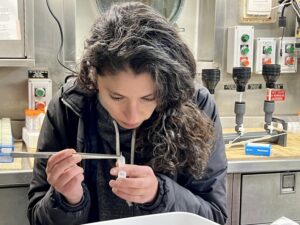
Scientist Rachel Kaplan collects krill to study later. CREDIT: Courtney Flatt
When the ship stopped at planned locations to sample, Kaplan collected krill.
She ever so carefully placed 2-centimeter krill in a small plastic vial, gingerly using tweezers to pluck them from a petri dish as if she were using chopsticks. Kaplan hoped to collect up to 30 krill each time to further study on land.
“I’m so sorry, little krill. Thank you for your sacrifice,” Kaplan whispered to each crustacean she collected, so sincerely that other crew members continued her apologies to the krill even when Kaplan wasn’t in the lab.
Scanning for whales
Throughout the rest of the survey the marine mammal observers sporadically saw whales.
The highlight for the spotters came six days into the survey, at the famed Heceta Head, named after Bruno de Hezeta, a Spanish lieutenant who commanded a warship that sailed along the Pacific Coast in 1775.
“As I approached the coast I sometimes found no bottom. This leads me to believe there are some reefs or sandbanks on this coast, which is also shown by the color of the water. In some places the coast ends in a beach, and in others in steep cliffs,” Hezeta wrote.
The waters he described make up an incredibly productive spot along the Northern California Current. Heceta Bank (pronounced HECK-eh-tuh Bank) is similar to a raised garden in the ocean, said Kris Bauer, another scientist aboard the Shimada.
“It’s just so plentiful with nutrients. It’s a really special place,” Bauer said.
Especially along the Heceta Bank, each whale sighting brought excitement to the entire boat. Marine mammal observers radioed the crew whenever something especially new popped into their line of vision.
“Bridge, bridge, flybridge,” Kaplan’s voice chimed over the crew’s radio one afternoon. “You may already have seen this, but we have killer whales ahead, just so you know.”
Whales ‘yonder’
As a way to lighten the long days, Barlow, Bird and Kaplan came up with their own lingo to describe how far away a potential whale might be: yonder, yonder-plus, and way-the-heck-yonder.
“We’ve just started saying, ‘Oh, look at that yonder blow,’ and if it’s really far away, it’s yonder-plus,” Bird explained of the group’s inside jargon.
“Or even closer is: right here,” Kaplan said. “It works surprisingly well.”
Days later, as a humpback whale surfaced feet from the ship, Bird looked over, laughing, and said, “So, there’s a humpback. It’s, um, right here.” No one on the flybridge missed that particular sighting.
More formally, the team tracked the distance and bearing of each sighting – a kindness for other researchers who surely couldn’t decipher the variations of “yonder” – in addition to identifying as many whales as possible. Some were simply unidentifiable – too far away, or only the brief poof of a spout, or blow, as the scientists called them.
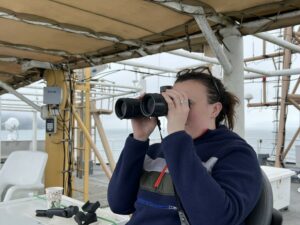
Scientist Clara Bird scans the horizon for any signs of whales. CREDIT: Courtney Flatt
“I have a blow at 1.5 kilometers, 290 degrees, still unidentified,” Barlow said one afternoon.
As the ship moved closer, Barlow identified four formerly faraway spouts as humpback whales.
The ship had to cruise at 8-knots or more for the group to conduct marine mammal surveys. Anything slower increased the chances of double counting a sighting.
Over the course of the trip, they spotted signs of 232 whales, 111 of which were humpbacks. A few rarer sightings spiced up the days, including an unexpected sei whale – many of the spotters’ favorite.
“Not much is known about the distribution patterns of sei whales, so it’s always interesting to see them,” Barlow said.
Also interesting, the scientists said, is an emerging area of research that shows whale excrement makes for a more productive ocean, like giant mobile fertilizers to help grow phytoplankton, which krill eat.
“I think, for a long time, people didn’t think about whales having a big role in ecosystems beyond their role as predators,” Kaplan said.
Now, these scientists are considering that and so much more.
“The questions we’re asking, no one knows the answer to,” Bird said. “That’s why it’s so exciting. No one knows.”
“We love that,” Kaplan said.
“We love that,” Bird echoed. “Science.”

